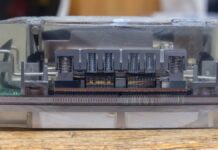Intel Core i3-9100F Power Consumption
We wanted to post a few figures from our testing that show the real selling point of the chips, low power.
- Idle Power (Performance Mode): 31W
- STH 70% Load: 75W
- STH 100% Load: 92W
- Maximum Observed Power (Performance Mode): 103W
Note these results were taken using a 208V Schneider Electric / APC PDU at 17.7C and 72% RH. Our testing window shown here had a +/- 0.3C and +/- 2% RH variance. 120V powered systems will run with more power.
The significance here is that these chips can safely be run in even 1A/120V colocation so long as the configuration is reasonable.
Intel Core i3-9100F Market Positioning
Thes chips are not released in a vacuum instead, they have competition on both the Intel and AMD sides. When you purchase a server and select a CPU, it is important to see the value of a platform versus its competitors.
The AMD side is still less competitive here. AMD’s embedded EPYC 3000 series performs well but is targeted at more cores/ threads, lower TDP, more expansion, and features like 10GbE.
While AMD could have a Ryzen competitor, there are only a handful of Ryzen server motherboards like the ASRock Rack X470D4U and Tyan Tomcat EX S8015 that are entering the space. Both of those are based on older-generation platforms. Contrast that with the robust ecosystem of LGA1151 servers and there is a huge delta that alone will keep people buying Intel. If Dell EMC, HPE, Lenovo, and Supermicro all offered Ryzen servers, that may change.

Intel competition comes in a number of fronts. The Core i3-9100 is going to be the most direct competitor adding iGPU features for $25 more. We think that if the features go unused the Core i3-9100F is worth taking the savings. If the GPU features, including Quick Sync transcoding or digital display outputs, will be used, then the Core i3-9100 is worth the small premium.
The other comparison we wanted to highlight is the Intel Xeon E-2224 which is also a 4 core/ 4 thread part. We have benchmarks ready for the server re-launch, but we cannot publish them the week this review is going live. What we will say is that with the same number of cores/ threads, no integrated GPU, and similar clock speeds, the performance is closer than the approximately 2x price premium would suggest.
Final Words
There are many folks running used hardware that consumes more power and has more performance for relatively mundane tasks. Operating a FreeNAS server is a great example. For most NAS devices, the Intel Core i3-9100F offers ample performance. This is more than comparable to the FreeNAS Mini XL Plus we reviewed.
Unless you absolutely need a feature found on Xeon, you will immediately see why we think the Core i3-9100F is a better value for around $100 less as soon as we can publish our Xeon E-2224 benchmarks.
In this generation, adding Turbo is not as good as adding additional cores, but it changes the chip to give a better single-thread performance. We think this is a great change.
Perhaps the bigger question here is whether the “F” is worth it. That “F” means that this chip has the same comptue power as the Intel Core i3-9100, just without the GPU. For many users, adding a GPU that has video outputs and transcoding engines that many running mixed workloads on servers will want.
Our end-of-day observation is that if you do not need the video for a low-end server, the Intel Core i3-9100F is a great option, especially compared to the Xeon E-2224. If you may need the video capabilities or are building a low-end workstation, you probably want the non-F model.




This is nice CPU but the problem I see here is that it is still renamed Kaby Lake B0 silion, therefore all the vulnerabilities like meltdown, spectre etc. apply to those CPUs. They apply to E-2224 as well unfortunatelly. The only fully fixed silicon is R0 stepping that is present only in E-2278G, E-2278GEL and E-2288G. I would love to buy i3 9300T but without security fixes, it is no go for me.
@Petr, agreed. But microcode updates should mitigate those issues?
Does i3 9100 has limited PCIE lanes compare to E2224?